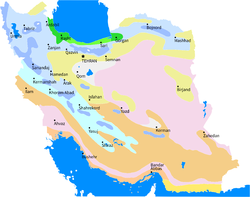
A | B | C | D | E | F | G | H | CH | I | J | K | L | M | N | O | P | Q | R | S | T | U | V | W | X | Y | Z | 0 | 1 | 2 | 3 | 4 | 5 | 6 | 7 | 8 | 9
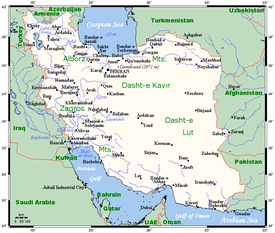 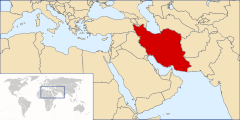 | |
| Continent | Asia |
|---|---|
| Region | West Asia[1][2][3] |
| Coordinates | 32°00'N, 53°00'E |
| Area | Ranked 17th |
| • Total | 1,648,195 km2 (636,372 sq mi) |
| • Land | 99.27% |
| • Water | 0.73% |
| Coastline | 2,815 km (1,749 mi) |
| Borders | Total land borders: 5,894 km (3,662 mi) Afghanistan: 921 km (572 mi) Armenia: 44 km (27 mi) Azerbaijan (proper): 432 km (268 mi) Azerbaijan (Nakhchivan exclave): 179 km (111 mi) Iraq: 1,599 km (994 mi) Pakistan: 909 km (565 mi) Turkey: 534 km (332 mi) Turkmenistan: 1,148 km (713 mi) |
| Highest point | Mount Damavand 5,610 m (18,406 ft) |
| Lowest point | Caspian Sea −28 m (−91.9 ft) |
| Longest river | Karun |
| Largest lake | Lake Urmia |
| Exclusive economic zone | 168,718 km2 (65,142 sq mi) |
Geographically, the country of Iran is located in West Asia and borders the Caspian Sea, Persian Gulf, and Gulf of Oman. Topographically, it is predominantly located on the Persian Plateau. Its mountains have impacted both the political and the economic history of the country for several centuries. The mountains enclose several broad basins, on which major agricultural and urban settlements are located. Until the 20th century, when major highways and railroads were constructed through the mountains to connect the population centers, these basins tended to be relatively isolated from one another.


Typically, one major town dominated each basin, and there were complex economic relationships between the town and the hundreds of villages that surrounded it. In the higher elevations of the mountains rimming the basins, tribally organized groups practiced transhumance, moving with their herds of sheep and goats between traditionally established summer and winter pastures. There are no major river systems in the country, and historically transportation was by means of caravans that followed routes traversing gaps and passes in the mountains. The mountains also impeded easy access to the Persian Gulf and the Caspian Sea.
With an area of 1,648,195 square kilometres (636,372 sq mi), Iran ranks seventeenth in size among the countries of the world. Iran shares its northern borders with several post-Soviet states: Armenia, Azerbaijan,[a] and Turkmenistan. These borders extend for more than 2,000 kilometres (1,200 mi), including nearly 650 kilometres (400 mi) of water along the southern shore of the Caspian Sea. Iran's western borders are with Turkey in the north and Iraq in the south, terminating at the Arvand Rud.
The Persian Gulf and Gulf of Oman littorals form the entire 1,770-kilometre (1,100 mi) southern border. To the east lie Afghanistan on the north and Pakistan on the far south. Iran's diagonal distance from Azerbaijan in the northwest to Sistan and Baluchestan province in the southeast is approximately 2,333 kilometres (1,450 mi).
Topography
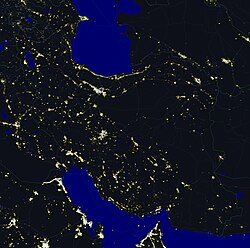

The topography of Iran consists of rugged, mountainous rims surrounding high interior basins. The main mountain chain is the Zagros Mountains, a series of parallel ridges interspersed with plains that bisect the country from northwest to southeast. Many peaks in the Zagros exceed 3,000 metres (9,843 ft) above sea level, and in the south-central region of the country there are at least five peaks that are over 4,000 metres (13,123 ft).
As the Zagros continue into southeastern Iran, the average elevation of the peaks declines dramatically to under 1,500 metres (4,921 ft). Rimming the Caspian Sea littoral is another chain of mountains, the narrow but high Alborz Mountains. Volcanic Mount Damavand, 5,610 metres (18,406 ft), located in the center of the Alborz, is not only the country's highest peak but also the highest mountain on the Eurasian landmass west of the Hindu Kush.
The center of Iran consists of several closed basins that collectively are referred to as the Central Plateau. The average elevation of this plateau is about 900 metres (2,953 ft), but several of the mountains that tower over the plateau exceed 3,000 metres (9,843 ft). The eastern part of the plateau is covered by two salt deserts, the Dasht-e Kavir (Great Salt Desert) and the Dasht-e Lut. Except for some scattered oases, these deserts are uninhabited.
Parts of northwestern Iran are part of the Armenian highlands, which adjoins it topographically with other parts of neighbouring Turkey, Armenia, Azerbaijan, and Georgia.[4]
Iran has only two expanses of lowlands: the Khuzestan Plain in the southwest and the Caspian Sea coastal plain in the north. The former is a roughly triangular-shaped extension of the Mesopotamia plain and averages about 160 kilometres (99 mi) in width. It extends for about 120 kilometres (75 mi) inland, barely rising a few meters above sea level, then meets abruptly with the first foothills of the Zagros. Much of the Khuzestan plain is covered with marshes.
The Caspian plain is both longer and narrower. It extends for some 640 kilometres (400 mi) along the Caspian shore, but its widest point is less than 50 kilometres (31 mi), while at some places less than 2 kilometres (1.2 mi) separate the shore from the Alborz foothills. The Persian Gulf coast south of Khuzestan and the Gulf of Oman coast have no real plains because the Zagros in these areas come right down to the shore.
There are no major rivers in the country. Of the small rivers and streams, the only one that is navigable is the 830 kilometres (520 mi)-long Karun, which shallow-draft boats can negotiate from Khorramshahr to Ahvaz, a distance of about 180 kilometres (110 mi). Other major rivers include the Karkheh, spanning 700 kilometres (430 mi) and joining the Tigris; and the Zayandeh River, which is 300 kilometres (190 mi) long. Several other permanent rivers and streams also drain into the Persian Gulf, while a number of small rivers that originate in the northwestern Zagros or Alborz drain into the Caspian Sea.
On the Central Plateau, numerous rivers—most of which have dry beds for the greater part of the year—form from snow melting in the mountains during the spring and flow through permanent channels, draining eventually into salt lakes that also tend to dry up during the summer months. There is a permanent salt lake, Lake Urmia (the traditional name, also cited as Lake Urmiyeh, to which it has reverted after being called Lake Rezaiyeh under Mohammad Reza Shah), in the northwest, whose brine content is too high to support fish or most other forms of aquatic life. There are also several connected salt lakes along the Iran-Afghanistan border in the province of Baluchestan va Sistan.
Iran's highlands are home to some of the world's most unexpected glaciers. Their appearance in the dry environment is advantageous for those who depend on glacial ice as a supply of fresh water. In an expedition, Klaus Thymann together with the environmental charity Project Pressure produced a series of archive and expedition photographs that depict the urgency of the situation surrounding climate change and the individuals who rely on such natural ice forms to sustain life in remote areas.[5]
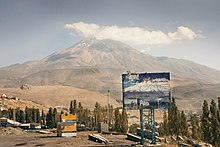
A recent global remote sensing analysis suggested that there were 1,481 km2 of tidal flats in Iran, making it the 22nd ranked country in terms of tidal flat area.[6]
Climate
Iran has a diverse climate. In the northwest, winters are cold with heavy snowfalls and sub-freezing temperatures. Spring and fall are relatively mild, while summers are dry and hot. In the south, winters are mild and summers are very hot, with average daily maximum temperature exceeding 38 °C (100.4 °F) in the month of July. On the Khuzestan Plain, summer heat is accompanied by high humidity.
In general, Iran has a temperate climate in which most of the relatively scant annual precipitation falls from October through April. In most of the country, yearly precipitation averages 400 millimetres (15.7 in) or less. The major exceptions are the higher mountain valleys of the Zagros and the Caspian coastal plain, where precipitation averages at least 600 millimetres (24 in) and is in the form of snow at high altitudes. In the western part of the Caspian, rainfall exceeds 1,500 millimetres (59 in) annually and is distributed relatively evenly throughout the year. This contrasts with some basins of the Central Plateau that receive 100 millimetres (4 in) or less of precipitation. Iran is considered colder than neighboring countries such as Iraq and Turkmenistan, due to its higher elevation.
Examples
| Climate data for Tehran Mehrabad - Altitude: 1190.8 m (1951-2010) | |||||||||||||
|---|---|---|---|---|---|---|---|---|---|---|---|---|---|
| Month | Jan | Feb | Mar | Apr | May | Jun | Jul | Aug | Sep | Oct | Nov | Dec | Year |
| Record high °C (°F) | 19.6 (67.3) |
23.0 (73.4) |
29.4 (84.9) |
33.4 (92.1) |
37.0 (98.6) |
41.0 (105.8) |
43.0 (109.4) |
42.0 (107.6) |
38.0 (100.4) |
33.4 (92.1) |
26.4 (79.5) |
21.0 (69.8) |
43.0 (109.4) |
| Mean daily maximum °C (°F) | 7.9 (46.2) |
10.6 (51.1) |
15.7 (60.3) |
22.2 (72.0) |
28.0 (82.4) |
34.0 (93.2) |
36.7 (98.1) |
35.7 (96.3) |
31.6 (88.9) |
24.5 (76.1) |
16.3 (61.3) |
10.1 (50.2) |
22.8 (73.0) |
| Daily mean °C (°F) | 3.8 (38.8) |
6.0 (42.8) |
10.7 (51.3) |
16.8 (62.2) |
22.1 (71.8) |
27.5 (81.5) |
30.3 (86.5) |
29.5 (85.1) |
25.5 (77.9) |
19.0 (66.2) |
11.6 (52.9) |
5.9 (42.6) |
17.4 (63.3) |
| Mean daily minimum °C (°F) | −0.4 (31.3) |
1.4 (34.5) |
5.7 (42.3) |
11.4 (52.5) |
16.3 (61.3) |
21.1 (70.0) |
24.0 (75.2) |
23.4 (74.1) |
19.4 (66.9) |
13.5 (56.3) |
6.8 (44.2) |
1.8 (35.2) |
12.0 (53.7) |
| Record low °C (°F) | −15.0 (5.0) |
−13.0 (8.6) |
−8.0 (17.6) |
−4.0 (24.8) |
2.4 (36.3) |
5.0 (41.0) |
14.0 (57.2) |
13.0 (55.4) |
9.0 (48.2) |
2.8 (37.0) |
−7.0 (19.4) |
−13.0 (8.6) |
−15.0 (5.0) |
| Average precipitation mm (inches) | 34.6 (1.36) |
33.2 (1.31) |
39.6 (1.56) |
31.9 (1.26) |
14.8 (0.58) |
3.0 (0.12) |
2.2 (0.09) |
1.7 (0.07) |
1.2 (0.05) |
10.7 (0.42) |
26.1 (1.03) |
33.7 (1.33) |
232.7 (9.18) |
| Average precipitation days | 9.0 | 8.6 | 10.7 | 10.8 | 8.8 | 3.1 | 2.1 | 1.3 | 1.1 | 5.3 | 7.2 | 8.6 | 76.6 |
| Average snowy days | 5.1 | 2.9 | 1.1 | 0.1 | 0.0 | 0.0 | 0.0 | 0.0 | 0.0 | 0.0 | 0.4 | 2.7 | 12.3 |
| Average relative humidity (%) | 64 | 56 | 47 | 40 | 33 | 25 | 26 | 26 | 27 | 36 | 49 | 62 | 41 |
| Mean monthly sunshine hours | 168.8 | 179.8 | 203.0 | 220.6 | 287.0 | 346.3 | 345.9 | 333.6 | 302.8 | 249.9 | 202.9 | 168.9 | 3,009.5 |
| Average ultraviolet index | 2 | 3 | 3 | 5 | 6 | 7 | 7 | 7 | 5 | 4 | 3 | 2 | 5 |
| Source 1: Iran Meteorological Organization (records),[7] (temperatures),[8] (precipitation),[9] (humidity),[10] (days with precipitation),[11] | |||||||||||||
| Source 2: Weather Atlas (UV),[14] | |||||||||||||
| Climate data for Tehran-Shomal (north of Tehran), altitude: 1549.1 m, from 1988–2010. | |||||||||||||
|---|---|---|---|---|---|---|---|---|---|---|---|---|---|
| Month | Jan | Feb | Mar | Apr | May | Jun | Jul | Aug | Sep | Oct | Nov | Dec | Year |
| Record high °C (°F) | 17.2 (63.0) |
21.2 (70.2) |
29.0 (84.2) |
32.4 (90.3) |
33.6 (92.5) |
39.2 (102.6) |
40.4 (104.7) |
39.6 (103.3) |
36.2 (97.2) |
31.2 (88.2) |
23.6 (74.5) |
19.6 (67.3) |
40.4 (104.7) |
| Mean daily maximum °C (°F) | 6.1 (43.0) |
8.6 (47.5) |
13.8 (56.8) |
20.0 (68.0) |
25.5 (77.9) |
31.6 (88.9) |
34.4 (93.9) |
33.6 (92.5) |
29.5 (85.1) |
22.8 (73.0) |
14.5 (58.1) |
8.6 (47.5) |
20.8 (69.4) |
| Daily mean °C (°F) | 2.3 (36.1) |
4.4 (39.9) |
9.2 (48.6) |
14.9 (58.8) |
19.8 (67.6) |
25.6 (78.1) |
28.5 (83.3) |
27.6 (81.7) |
23.4 (74.1) |
17.2 (63.0) |
9.9 (49.8) |
4.8 (40.6) |
15.6 (60.1) |
| Mean daily minimum °C (°F) | −1.5 (29.3) |
0.2 (32.4) |
4.6 (40.3) |
9.8 (49.6) |
14.2 (57.6) |
19.7 (67.5) |
22.6 (72.7) |
21.6 (70.9) |
17.3 (63.1) |
11.7 (53.1) |
5.3 (41.5) |
0.9 (33.6) |
10.5 (51.0) |
| Record low °C (°F) | −13.0 (8.6) |
−11.0 (12.2) |
−8.0 (17.6) |
−1.6 (29.1) |
3.0 (37.4) |
12.0 (53.6) |
15.4 (59.7) |
13.5 (56.3) |
8.8 (47.8) |
2.6 (36.7) |
−5.2 (22.6) |
−9.6 (14.7) |
−13.0 (8.6) |
| Average precipitation mm (inches) | 61.9 (2.44) |
68.3 (2.69) |
73.9 (2.91) |
53.2 (2.09) |
24.0 (0.94) |
4.9 (0.19) |
3.8 (0.15) |
2.5 (0.10) |
3.8 (0.15) |
18.4 (0.72) |
41.5 (1.63) |
64.3 (2.53) |
420.5 (16.54) |
| Average precipitation days | 12.3 | 10.9 | 12.3 | 10.0 | 8.9 | 3.3 | 3.4 | 1.6 | 1.3 | 5.8 | 8.6 | 10.7 | 89.1 |
| Average snowy days | 8.9 | 6.6 | 2.5 | 0.1 | 0.1 | 0 | 0 | 0 | 0 | 0 | 0.6 | 4.9
Zdroj:https://en.wikipedia.org?pojem=Climate_of_Iran Text je dostupný za podmienok Creative Commons Attribution/Share-Alike License 3.0 Unported; prípadne za ďalších podmienok. Podrobnejšie informácie nájdete na stránke Podmienky použitia.
Analytika
Antropológia Aplikované vedy Bibliometria Dejiny vedy Encyklopédie Filozofia vedy Forenzné vedy Humanitné vedy Knižničná veda Kryogenika Kryptológia Kulturológia Literárna veda Medzidisciplinárne oblasti Metódy kvantitatívnej analýzy Metavedy Metodika Text je dostupný za podmienok Creative
Commons Attribution/Share-Alike License 3.0 Unported; prípadne za ďalších
podmienok. www.astronomia.sk | www.biologia.sk | www.botanika.sk | www.dejiny.sk | www.economy.sk | www.elektrotechnika.sk | www.estetika.sk | www.farmakologia.sk | www.filozofia.sk | Fyzika | www.futurologia.sk | www.genetika.sk | www.chemia.sk | www.lingvistika.sk | www.politologia.sk | www.psychologia.sk | www.sexuologia.sk | www.sociologia.sk | www.veda.sk I www.zoologia.sk | |

